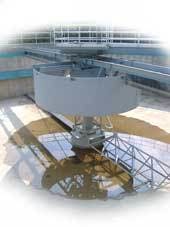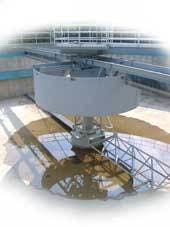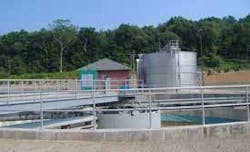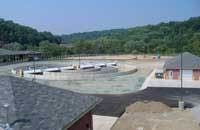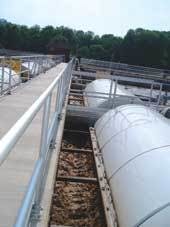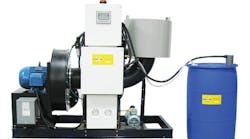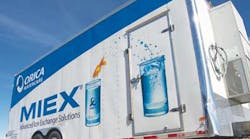by Chad E. Hanley
The Saxonburg Area Authority (SAA) is nearing completion on a wastewater treatment system expansion that has seen its service area almost double in size. Previously, the authority served three municipalities: Saxonburg Borough, Jefferson Township and Clinton Township in Butler County, PA. Now the authority will be serving five municipalities (including Penn Township and Middlesex Township) with capacity to add two more.
Regionalization efforts like this bring many economies of scale but they also bring great challenges, and SAA’s experience offers insight for other municipalities evaluating regionalization efforts or similarly scaled system expansions.
The Project
Each of the municipalities participating in this project brought their own needs to the table. Saxonburg’s existing wastewater treatment facility was in need of a significant upgrade, while Middlesex Township had an approved sewage facilities plan to build a wastewater system, and Penn Township was under an order from the Pennsylvania Department of Environmental Protection to finalize its own sewage facilities plan. By regionalizing wastewater treatment, the communities were able to meet their needs more cost effectively than they could have on their own.
The Challenges Negotiating Sanitary Sewage Provider Agreements
While they may agree to combine forces on wastewater treatment, each municipality remains its own entity. Thus, it has its own needs to protect and its own citizens’ best interests to serve. And each municipality has to give a little for the greater good of all involved. This negotiation can often take months or even years to complete, and the dance continues throughout the life of the agreement as new issues arise.
For this project, the sewage provider negotiations went fairly smoothly. The SAA prepared feasibility studies that demonstrated the project’s cost effectiveness, and SAA’s solicitor prepared draft agreements during the final planning stage with the Pennsylvania Department of Environmental Protection.
The biggest contention was the make-up of the board. Both Penn and Middlesex Townships were requiring a seat on the board as part of the agreement, but Saxonburg Borough (the incorporating municipality) did not want to give up the majority voice on the board. To satisfy all sides, Saxonburg Borough expanded the board to nine members, consisting of five seats for Saxonburg Borough and one seat each for Clinton, Jefferson, Middlesex and Penn Townships.
After a thorough review of the agreements by the townships and their consultants, the agreements were finalized for a vote. The townships were then incorporated into SAA.
Still, even with an agreement in place, another disagreement occurred during the design phase of the project over which homes the SAA would serve. The original agreement stated that the SAA would service homes and businesses that were cost effective and as shown in the sewage facilities plan, but one municipality wanted to exclude homes that were far off the road, on large plots of land, or in private developments. Prior to joining SAA, this municipality had done its own sewage facilities planning, and it had told residents that they would not have to tie into the sewage system if their homes were more than 150 feet off the road. Therefore, they wanted to honor their word to their residents. Ultimately, however, the SAA board decided to serve all homes and businesses that were cost effective, as outlined in the original agreement.
Dividing Costs
One of SAA’s main goals was to ensure that the financial breakdown of the project was as fair to everyone as possible and that each municipality shared the costs for the benefits they received. Although not everything could be perfect, some concessions had to be made.
For example, as a condition of the PennVEST loan, the member municipalities were required to guarantee the entire loan. However, the three municipalities originally served by SAA did not want to guarantee the debt being incurred to expand the system into the new municipalities. Therefore, the two new municipalities, Penn Township and Middlesex Township, split the loan guarantee 50-50.
The rate structure of the system was also developed with great care to ensure costs were shared fairly. For the most part, all of the existing customers of SAA’s wastewater system were also water customers. These customers were billed based on their water usage, but the new customers were on private wells and were not going to be billed based on usage. Therefore, a monthly flat rate was developed in order to maintain as much fairness across the system as possible.
In addition, tap-in fees for the expanded system were made the same as for a new customer tapping in to the existing portion of the system
Achieving Consensus
For this project, SAA added more than 400,000 linear feet of collector sewers in Penn and Middlesex Township and more than 43,000 linear feet of interceptor sewer connecting the existing WWTF to a new 2.052 mgd treatment facility. They also added approximately 1,850 customers to their base.
Approximately 1,700 easements were needed from private property owners for this expansion, and securing these easements required many public meetings, phone calls, field visits, and alignment adjustments.
Public meetings offered residents in the various municipalities an opportunity to ask questions about sewer easements through their property, the location of pump stations, and sewer tap-in procedures. Residents also had an opportunity to make comments at the regular authority board meetings, and they even were given “tap flags” to place along the alignment to indicate where they wanted their tap to be constructed. Throughout the process, one of the authority’s engineers, Herbert, Rowland & Grubic, Inc. (HRG), made hundreds of design and alignment changes to accommodate the public’s wishes as closely as was feasible without adding cost to the project.
Still, not everyone’s wishes could be met exactly, and some residents were frustrated to be required to pay tap-in fees and join the public sewer system.
Despite these obstacles, however, regionalization has offered the Saxonburg Area Authority and its customers many benefits already.
The Benefits
It’s a basic tenet of economics 101: As you purchase greater quantities of an item, the unit price for that item typically goes down. Thus, the cost of constructing one large wastewater treatment system to serve the five municipalities was much lower than the cost of upgrading one (Saxonburg) and building two others (Penn and Middlesex Townships).
Lower Costs
While construction costs are heavy up front for any infrastructure, operation and administrative costs really add up for a treatment system over the long term. This is where one of the greatest benefits of regionalization occurs. The SAA already had an existing staff to support their treatment, maintenance and administrative needs. In order to manage the expanded system, that staff only needed a few additions. If this was undertaken as three separate projects, the other two townships would have had to employ full staffs to perform the same duties. By combining the project under one entity, duplication of staff and resources was eliminated.
Lower Rates
With regionalization, costs incurred by the authority can be spread over a larger population; therefore, the costs will be lower to each individual user. Also, future cost increases (like chemical or fuel costs or an insurance rate hike) that could have a major rate impact on small treatment systems will have a much lower impact per user on a large, regional system.
For SAA, the savings this project produced in user fees is approximately $15-20 per month per customer. Because costs are now being shared among a much larger pool of customers, future cost increases incurred by the authority will have a much lower impact per user; therefore, customer rates should remain steady for many years to come.
Reduced Oversight
SAA is not the only one who benefits from this regionalization; the regulatory agencies in charge of environmental protection do too, through a reduced regulatory burden. Had SAA gone through its own expansion and Penn and Middlesex Townships built their own wastewater treatment systems, as initially planned before the regionalization, DEP would’ve had to monitor the discharge of three different treatment facilities, but now they only have to monitor one. In addition, they are able to monitor the discharge of an entity with a proven track record (SAA), rather than two start-up systems by Penn and Middlesex Townships.
About the Author:
Chad Hanley, P.E., is an environmental project manager at Herbert, Rowland & Grubic, Inc. (HRG), a full service civil engineering firm offering water and wastewater, transportation, surveying, water resources, environmental engineering, and land development services throughout the Mid-Atlantic Region. He can be reached by phone at (724) 779-4777 or by email at [email protected].
